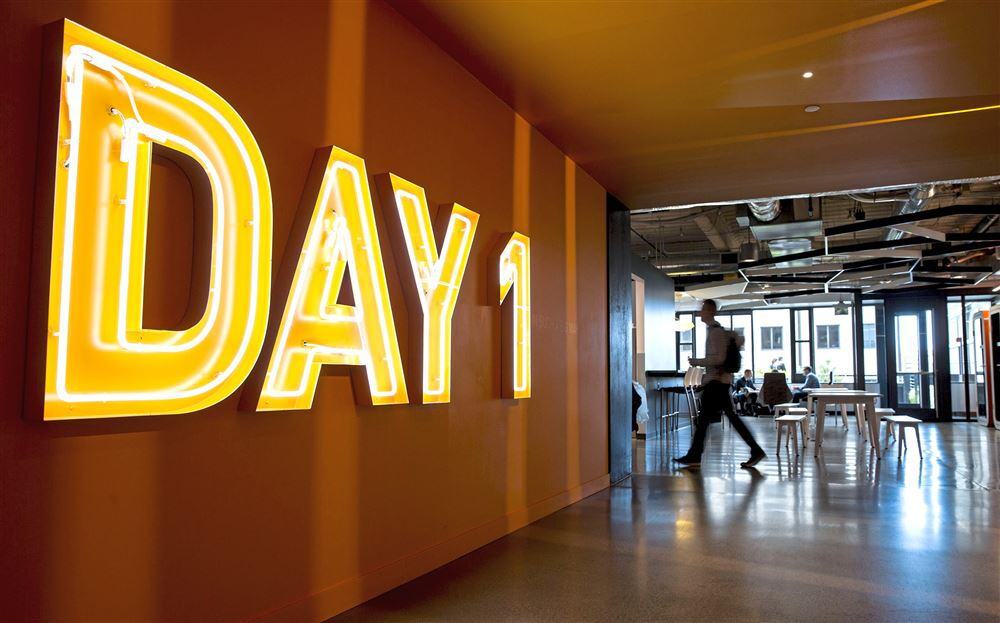Amazon Explained – The Flywheel
Podean’s Amazon Explained Series delivers insights into the drivers of Amazon’s success. Amazon CEO and founder, Jeff Bezos has taken hold of a...

In Jeff Bezos’ letters to shareholders he often mentions how Amazon executives read 6-page memos (called “narratives”) at the start of every meeting.
And yes, PowerPoint is rarely used (except by sales people who interact with the outside world where it’s expected by clients and agencies) and definitely frowned upon within Amazon’s walls.
It’s seen as a way to hide behind poorly thought-through bullets, and big images and doesn’t require the author to thoroughly think through what they are proposing.
Conversely, the “narrative” memos don’t just outline the agenda, and they aren’t read aloud either – everyone in the room takes about thirty minutes to read these memos in complete silence. These memos tend to cover a wide range of topics and, according to Bezos, are more about the writer than the reader.
Bezos says: “Not surprisingly, the quality of these memos varies widely, some have the clarity of angels singing. They are brilliant and thoughtful and set up the meeting for high-quality discussion. Sometimes they come in at the other end of the spectrum.”
Bezos said that you just can’t come up with a great memo in a day. In fact, he suggests that the best memos take a week or so to write. Reading a 6-page memo might seem like a waste of time for a high-end executive, but these narratives are all about the team that puts them together. By being assigned to write a detailed memo on what you are working on and addressing within the company, you are forced to think about it in a more critical and well thought-out manner.
Bezos says “The best memos are written and rewritten, shared with colleagues who are asked to improve the work, set aside for a couple of days, and then edited again with a fresh mind.”
The fact that working on these reports takes so much thought and creativity seems to be the whole point. See, anyone can throw together a quick PowerPoint right before a meeting and pretend everything is well thought out, but these executive meetings are not about brainstorming – they are about making decisions and communicating. The brainstorming process needs to take place prior to the meeting, and it needs to be happening every day – writing a memo report helps facilitate that.
Bezos explains that although it’s hard to differentiate a good memo from a great one, people know a great one when they see it. When Bezos reads a great memo, he’s more excited to see that the team knows what they’re doing than he is to read the memo itself.
So why do the execs take the time to read the memo at the start of the meeting? After all, they each have plenty of other things they can be doing with their time. Well, first off, reading the memo can allow them to see what’s going on within the company, but more importantly, it shows them the focus of the department that wrote the memo (or lack thereof.) Second, it encourages a culture of excellence, both for the execs and the teams writing the memos.
Bezos agrees that silently reading the memos together is the “weirdest meeting culture,” but it serves the purpose of encouraging everyone involved to focus and to be excellent. Excellence requires attention, and good memo writing requires attention. Bezos seems to be killing two birds with one stone here. By requiring the silent start to the meetings, he demands the full attention of his execs, and by requiring the production of well-written memos, he demands laser-focused team management.
When an excellent memo is written, the author is forced to be more precise than he or she might be in person. By taking the time to thoroughly think through a lengthy narrative memo, the author makes it clear what needs to be done so there will be no unnecessary questions moving forward.
When everyone within a company is focused on excellence, communication, and attention to detail the standards will be set at a high level. High standards mean that you will build better products and services for your customers.
Discover more about Amazon in our Explained series:
<p>

Podean’s Amazon Explained Series delivers insights into the drivers of Amazon’s success. Amazon CEO and founder, Jeff Bezos has taken hold of a...

Amazon CEO Jeff Bezos has always been a strong proponent of the “Day 1” business outlook. In fact, he’s preached the idea so often that it has become...

When Amazon begins the process of developing a new product or website feature, the project manager in charge starts the venture off by writing a...
